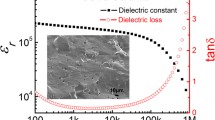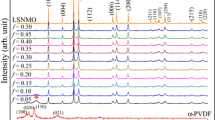Abstract
Polytetrafluorethylene (PTFE) composites filled with perovskite (Ca,Li,Sm)TiO3 (CLST) dielectric ceramic of various volume fractions filler up to 60% were prepared. The effects of volume fraction of ceramic filler on the microstructure and dielectric properties of the composites have been investigated. A comparative study of dielectric properties of experiment and modeling analysis has been carried out at high frequencies for the CLST/PTFE composites. The results indicate that both the dielectric constant and the dielectric loss increase with the filler. The CLST/PTFE composite with 40% ceramic has exhibited good dielectric properties: ε r = 7.92 (~10 GHz), tan δ = 1.2 × 10−3 (~10 GHz), and τ f = −45 ppm/°C. The dielectric properties are obviously better than most composites reported previously at high frequencies in the aspects of dielectric loss and thermal stability. The dielectric constant and dielectric loss of composites predicted by the Rother–Lichtenecker equation and the general mixing model are in good agreement with the experiment data when the volume fraction of ceramic is less than 40%. When the volume fraction of the ceramic is more than 40%, the deviation occurs. By introducing the correction factor, the theoretical values of the dielectric constant agrees well with the experimental values.






Similar content being viewed by others
References
Y. Yang, B.P. Zhu, Z.H. Lu, Z.Y. Wang, C.L. Fei, D. Yin, R. Xiong, J. Shi, Q.-G. Chi, Q.-Q. Lei, Polyimide, nanosized CaCu3Ti4O12 functional hybrid films with high dielectric permittivity. Appl. Phys. Lett. 102, 042904 (2013)
P. Thomas, K.T. Varughese, K. Dwarakanath, K.B.R. Varma, Dielectric properties of poly(vinylidene fluoride)/CaCu3Ti4O12 composites. Compos. Sci. Technol. 70, 539–545 (2010)
L. Zhang, J. Zhao, E.Q. Huang, J.W. Zha, Z.M. Dang, Preparation and dielectric properties of (Ba0.5Sr0.4Ca0.1)TiO3/polystyrene composites. J. Appl. Polym. Sci. 132, 1–6 (2015)
Y.Y. You, Y. Yuan, K.T. Wu, Q.M. Zhang, J. Yang, X. Yang, The dielectric and thermal properties of Mn-doped (1−x) ZrTi2O6–xZnNb2O6 filled PTFE composites. J. Mater. Sci. 25, 3010–3015 (2014)
S. Rajesh, K.P. Murali, V. Priyadarsini, S.N. Potty, R. Ratheesh, Rutile filled PTFE composites for flexible microwave substrate applications. Mater. Sci. Eng. B 163, 1–7 (2009)
S. Rajesh, K.P. Murali, H. Jantunen, R. Ratheesh, The effect of filler on the temperature coefficient of the relative permittivity of PTFE/ceramic composites. Physica B 406, 4312–4316 (2011)
S. Rajesh, K.P. Murali, R. Ratheesh, Preparation and characterization of high permittivity and low loss PTFE/CaTiO3 microwave laminates. Polym. Compos. 30, 1480–1485 (2009)
K.P. Murali et al., Preparation and characterization of cordierite filled PTFE laminates for microwave substrate applications. J. Mater. Sci. 21, 192–198 (2010)
T. Suwa et al., Effect of molecular weight on the crystalline structure of polytetrafluoroethylene as-polymerized. J. Polym. Sci. 13, 2183–2194 (1975)
L. Ramajo et al., Dielectric response and relaxation phenomena in composites of epoxy resin with BaTiO3 particles. Compos. Part A 36, 1267–1274 (2005)
A. Sihvola, J.A. Kong, Effective permittivity of dielectric mixtures. IEEE Trans. Geosci. Remote Sens. 26, 420–429 (1988)
K. Sonod, J. Juuti, Y. Moriya, H. Jantunen, Modification of the dielectric properties of 0–3 ceramic-polymer composites by introducing surface active agents onto the ceramic filler surface. Compos. Struct. 92, 1052–1058 (2010)
M.T. Sebastian, H. Jantunen, Polymer-Ceramic composites of 0-3 connectivity for circuits in electronics: a review. J. Appl. Ceram. Technol. 7, 415–434 (2010)
G. Subodh, V. Deepu, P. Mohanan, M.T. Sebastian, Dielectric response of high permittivity polymer ceramic composite with low loss tangent. Appl. Phys. Lett. 95, 062903 (2009)
Acknowledgements
This work has been supported by the National Natural Science Foundation of China (51572205) and The Natural Science Foundation of Hubei Province, China (2014CFB854). The authors thank the Testing Center, Wuhan University of Technology for SEM measurements.
Author information
Authors and Affiliations
Corresponding authors
Rights and permissions
About this article
Cite this article
Zheng, L., Zhou, J., Shen, J. et al. The dielectric properties and dielectric mechanism of perovskite ceramic CLST/PTFE composites. J Mater Sci: Mater Electron 28, 11665–11670 (2017). https://doi.org/10.1007/s10854-017-6969-4
Received:
Accepted:
Published:
Issue Date:
DOI: https://doi.org/10.1007/s10854-017-6969-4




